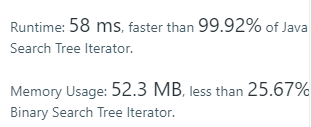链接:
https://leetcode.com/problems/binary-search-tree-iterator/
大意:
构造一棵BST的迭代器,迭代器通过往构造函数传入树根节点得到,实现迭代器的两个函数next()和hasNext(),用于获得迭代器的下一个元素以及判断是否有下一个元素。例子:

思路:
在构造迭代器时(构造函数内),使用一个list存储BST中序遍历,并设置一个实例域currIdx为当前遍历到迭代器的位置,另一个实例域size为BST中序遍历的长度。具体代码如下。
代码:
/**
* Definition for a binary tree node.
* public class TreeNode {
* int val;
* TreeNode left;
* TreeNode right;
* TreeNode(int x) { val = x; }
* }
*/
class BSTIterator {
private ArrayList<Integer> order = new ArrayList<>();
private int currIdx;
private int size;
public BSTIterator(TreeNode root) {
inOrder(root);
currIdx = -1;
size = order.size();
}
/** @return the next smallest number */
public int next() {
if (hasNext())
return order.get(++currIdx);
return -1; // 表示不存在下一个元素
}
/** @return whether we have a next smallest number */
public boolean hasNext() {
return currIdx < size - 1;
}
private void inOrder(TreeNode root) {
if (root == null)
return ;
inOrder(root.left);
order.add(root.val);
inOrder(root.right);
}
}
/**
* Your BSTIterator object will be instantiated and called as such:
* BSTIterator obj = new BSTIterator(root);
* int param_1 = obj.next();
* boolean param_2 = obj.hasNext();
*/结果:

结论:
next()和hasNext()的时间复杂度均为O(1)。使用的空间复杂度为O(n),n为树节点的个数。题目最后的提示是最优解法的空间复杂度为O(h),h为树的高度。有待改进。。。
最佳:
class BSTIterator {
LinkedList<TreeNode> st;
public BSTIterator(TreeNode root) {
st = new LinkedList<>();
while (root != null) {
st.offerFirst(root);
root = root.left;
}
}
public int next() {
int val = st.peekFirst().val;
TreeNode n= st.pollFirst();
TreeNode r = n.right;
while (r!=null) {
st.offerFirst(r);
r = r.left;
}
return val;
}
public boolean hasNext() {
return !st.isEmpty();
}
}方法确实巧妙。首先存储左斜枝的节点值,待next拿掉一个当前最小的节点后,将被拿节点的右子树作为新的root,将root以及的左斜枝添加到list首部中。